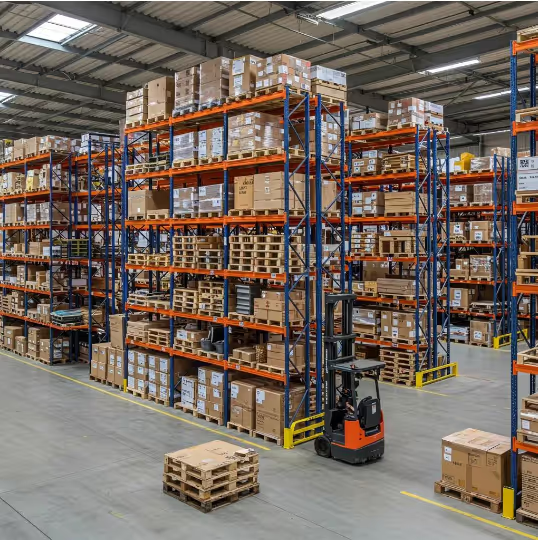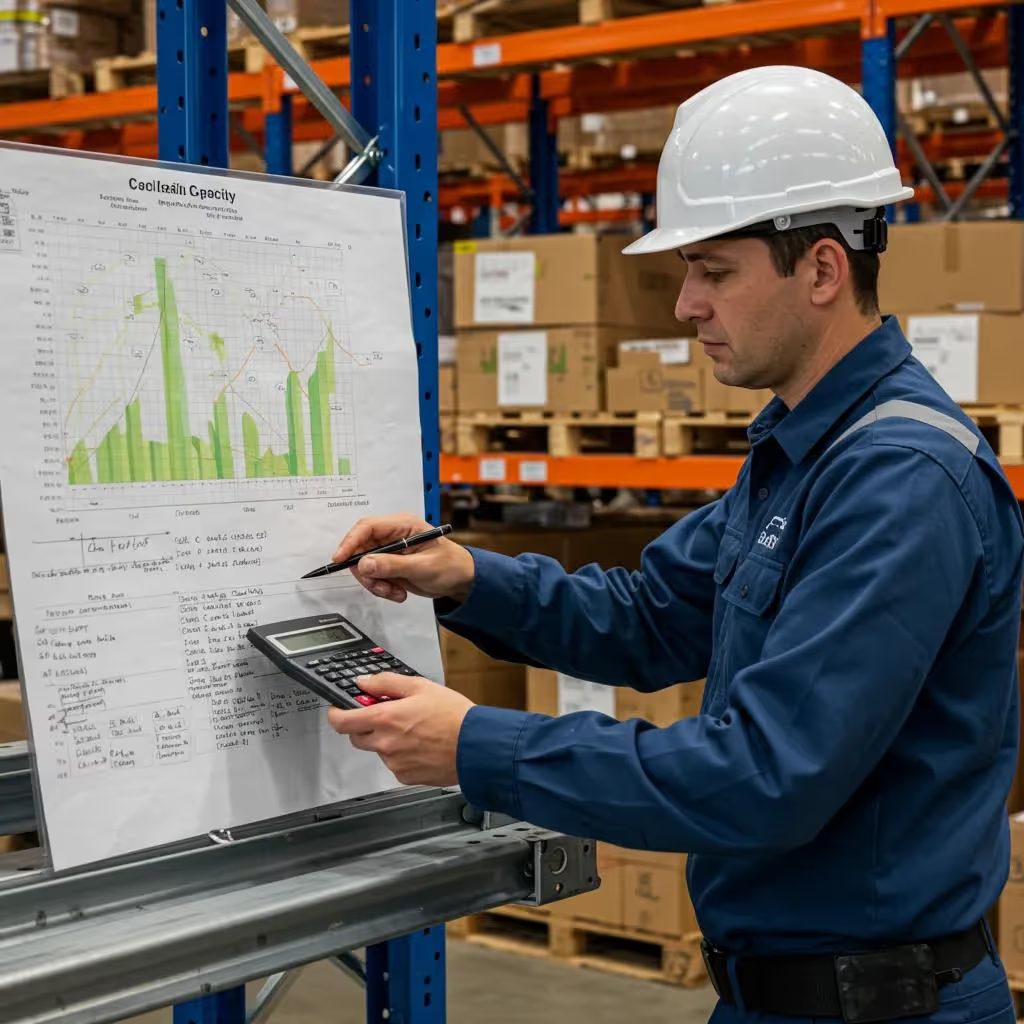
Accurately calculating pallet racking weight capacity is essential to prevent structural failures, protect personnel, and maximise storage efficiency in busy warehouse operations. This guide reveals the step-by-step methods for assessing beam and upright capacities, determining pallet loads, and integrating safety factors backed by Skyteck Online’s engineering expertise. You will learn:
- What core components determine rack capacity and how to quantify each
- Which material, spacing, load-type, deflection, and environmental factors influence overall strength
- How OSHA, RMI/ANSI standards, safe working loads, and inspection routines ensure compliance
- How Skyteck Online customises racking solutions and integrates material-handling equipment
- Which calculation tools, charts, and professional services deliver precise capacity assessments
- How to optimise warehouse layout and maintain long-term rack integrity
Throughout this guide, “pallet racking weight capacity” serves as our central concept, with entity relationships mapped between beams, uprights, pallets, safety factors, and regulatory benchmarks.
What Are the Core Components of Pallet Racking Weight Capacity?
Pallet racking weight capacity represents the maximum load a storage system can safely support. It relies on three interdependent entities such as horizontal beams, vertical upright frames, and individual pallet loads, each contributing to overall structural integrity and storage efficiency.
What Is Beam Capacity and How Is It Calculated?

Beam capacity defines the maximum uniform load that a pair of horizontal beams can carry without yielding or excessive deflection. It depends on beam span, cross-sectional profile, material grade, connector type, and allowable deflection limit.
Key factors influencing beam capacity include:
- Span Length – The distance between uprights dictates bending moment and sag.
- Section Modulus – Beam depth and profile determine bending resistance.
- Steel Grade – Higher yield strength alloys increase load-bearing potential.
- Connector Integrity – Clip-in or bolt-on connectors must match beam rating.
- Deflection Limit – Industry standard L/180 or L/240 ensures minimal sag under load.
Calculating beam capacity begins by referencing manufacturer load charts, then applying:
Summary: Beam capacity governs shelf strength and transitions directly into how upright frames distribute that load vertically.
How Do Upright Frames Affect Overall Rack Load Capacity?
Upright frame capacity represents the total vertical load a column assembly can sustain across multiple levels, combining the weight from all beam pairs. Frame capacity is governed by column thickness, bracing design, anchor type, frame height, and cumulative load distribution.
Primary upright attributes include:
- Column Dimensions – Height, cross-sectional flange size, and thickness
- Bracing Configuration – Horizontal and diagonal braces prevent sway and buckling
- Anchor Method – Floor plate anchors transfer loads safely to slab
- Level Spacing – Beam pitch influences load per foot of frame
- Cumulative Load – Sum of loads from each shelf level
Calculating frame capacity involves summing the design loads of beam pairs plus pallet weight, then comparing against the frame’s rated capacity from manufacturer data. This ensures vertical integrity and aligns with beam capacity limits.
How Do You Determine Pallet Load Weight for Accurate Capacity Calculation?
A pallet’s total load weight combines the empty pallet weight and the weight of stored goods. Precise measurement prevents overloading at the point of contact between pallet and beam.
Considerations for pallet load weight:
- Empty Pallet Weight – Typically 30–60 lbs for standard wooden pallets
- Product Weight – Net or gross weight including packaging
- Load Distribution – Centered versus off-center loads affect beam stress
- Dynamic Impact – Forklift placement or movement can add impact loads
Accurate pallet weight data completes the capacity equation, linking beam and frame ratings to real-world storage scenarios and preventing point-load overstress on individual beams.
Which Key Factors Influence Pallet Rack Load Capacity?
Pallet rack load capacity hinges on material properties, geometric spacing, load distribution types, allowable deflection, and environmental or seismic conditions.
How Does Material Quality and Construction Impact Rack Strength?
Material grade and fabrication quality directly affect yield strength, toughness, and long-term durability under repeated loading cycles. Cold-formed high-strength steel yields consistent section properties, while hot-rolled steel offers thicker profiles.
Key material considerations:
- Steel Yield Strength – Higher grades (e.g., ASTM A992) boost load limits
- Sheet Thickness – Thicker flanges resist local buckling in uprights
- Welding Quality – Continuous, defect-free welds maintain bracing integrity
- Protective Coatings – Galvanised or powder-coat finishes reduce corrosion
Superior material quality increases both beam and upright capacities, ensuring rack stability under dynamic warehouse conditions.
Why Are Beam Spacing and Length Important to Load Capacity?
Beam spacing (vertical pitch) and span length establish bending moments and deflection behavior. Wider spacing allows more pallet levels but increases per-level load on uprights.
- Wider Spacing – Fewer beams per frame raise load per beam pair
- Longer Span – Higher moment arms amplify deflection and bending stress
- Pitch Optimisation – Balances storage density with allowable load
Effective beam and frame design coordinates spacing and span to align rated capacities and minimises over-stress risks.
What Is the Difference Between Uniform Distributed Load and Point Loads?

How Do Deflection Limits Ensure Structural Integrity?
Deflection measures beam sag under load; industry standards such as L/180 or L/240 define maximum allowable sag relative to beam span. Controlling deflection prevents permanent deformation and pallet instability.

Maintaining deflection within specified limits aligns beam performance with load requirements and protects stored goods from damage.
How Do Environmental and Seismic Conditions Affect Rack Capacity?
Regional seismic zone and environmental factors such as temperature fluctuations and humidity, alter material properties and introduce dynamic forces. Seismic bracing and anchor reinforcement ensure rack integrity during earthquakes.
- Seismic Zone Requirements – Bracing patterns and anchor embedment vary by region
- Temperature Effects – Steel strength may change in extreme cold or heat
- Corrosive Environments – Moisture or chemical exposure necessitates protective coatings
Designing for site-specific conditions secures racking systems against environmental and seismic stresses.
How Do Safety Standards and Compliance Affect Pallet Racking Capacity?

Compliance with OSHA regulations and RMI/ANSI standards ensures that rack designs incorporate adequate safety factors, inspection protocols, and load ratings to protect personnel and assets.
What Are the Key OSHA and RMI/ANSI Pallet Rack Safety Guidelines?
OSHA 29 CFR 1910.176 and RMI/ANSI MH16.1 specify requirements for rack design, installation, and labeling. These guidelines mandate:
- Load Rating Labels – Visible beam capacity plaques at each level
- Anchor and Bracing – Minimum anchor embedment depths and bracing patterns
- Inspector Qualifications – Competent persons for structural assessments
- Training Requirements – Operator and maintenance staff education
Adhering to these standards underpins safe working conditions and legal compliance.
Design and Analysis of Static Pallet Racking Systems
ABSTRACT: Crosbie, Matthew William James. Sheffield Hallam University (United Kingdom). ProQuest Dissertations & Theses, 1998. 10694395.
The design and analysis of static pallet racking systems, 1998
How Is Safe Working Load (SWL) Defined and Calculated?
Safe Working Load (SWL) represents the maximum load permissible under normal use, determined by dividing theoretical capacity by a safety factor (commonly 1.5 to 2.0).
Applying SWL prevents accidental overload and accommodates unexpected dynamic impacts, preserving rack performance and operator safety.
Why Are Regular Inspections and Maintenance Essential for Safety?
Routine inspections detect damage that can erode capacity over time. A systematic maintenance program includes:
- Daily Visual Checks – Identifying bent frames, loose bolts, or dented beams
- Monthly Competent Person Inspections – Documenting wear, corrosion, or deformation
- Annual Professional Assessments – Engineering evaluation of structural integrity
Early detection and timely repair uphold rated capacities and extend service life.
How Does Skyteck Online Customise Pallet Racking Solutions for Optimal Capacity?
Skyteck Online blends in-house engineering expertise with site-specific assessments to deliver customised racking systems that precisely match load requirements and operational workflows.
How Does Skyteck Online Design and Engineer Customised Racking Systems?
Skyteck Online begins with a comprehensive needs analysis, measuring warehouse dimensions, identifying product characteristics, and assessing material-handling traffic patterns. Engineers then:
- Select beam and upright profiles rated for projected loads.
- Configure bracing and anchor schemes for regional seismic codes.
- Optimise beam spacing and frame heights for maximum usable levels.
- Validate deflection performance against customer tolerances.
This tailored approach enhances safety, storage density, and workflow efficiency from day one.
How Is Material Handling Equipment Compatibility Integrated into Rack Design?
By coordinating aisle widths, beam clearance heights, and forklift turning radii, Skyteck Online ensures seamless integration of pallet trucks and forklifts. Equipment clearance is validated through:
- Aisle Width Calculations – Balancing space utilisation with maneuverability
- Overhead Clearance – Ensuring safe mast travel beneath beams
- Load Transfer Points – Aligning beam levels with typical pallet heights
Integrating equipment parameters preserves throughput and maintains load capacity under dynamic operations.
What Tools and Methods Can Help Calculate Pallet Rack Load Capacity Accurately?
Accurate capacity calculation relies on manufacturer load charts, structural formulas, interactive software calculators, and professional engineering support.
How Can You Use Formulas and Load Charts for Capacity Calculation?
Start by referencing beam and frame load charts to identify rated capacities based on span, profile, and material. Then apply simple formulas:
- Beam Capacity (lbs) = Chart Capacity
- Frame Capacity (lbs) = Sum of Beam Loads + Pallet Loads
- SWL (lbs) = Rated Capacity ÷ Safety Factor
These calculations yield immediate estimates for uniform loads, while engineering tables refine point-load scenarios.
What Are the Benefits of Using Interactive Pallet Rack Capacity Calculators?
Software-based calculators accelerate assessments by allowing input of custom span lengths, section moduli, material grades, and pallet weights. Benefits include:
- Real-time load-rating adjustments for various configurations
- Automated deflection and safety factor checks
- Generation of printable capacity reports and beam labels
Interactive tools minimise human error and streamline compliance documentation.
When Should You Consult Professionals for Load Capacity Assessment?
Complex installation environments, unusually heavy or dynamic loads, or seismic compliance requirements call for licensed structural engineers. Professional services include:
- Finite element analysis for irregular loads
- Customised rack load certificates
- On-site verification of anchor embedment and bracing performance
Expert consultation ensures full compliance and reliable long-term performance.
How Can You Optimise Warehouse Layout to Maximise Pallet Racking Capacity?
Warehouse layout optimisation blends racking type selection, dimension planning, and equipment integration to enhance storage density and flow efficiency.
What Are the Different Types of Pallet Racking Systems and Their Load Capacities?

How Do Warehouse Dimensions and Aisle Widths Influence Rack Capacity?
Aisle width directly affects the number of rack bays and thus total capacity. Narrow aisles increase rack density but require specialised forklifts. Dimension planning balances:
- Throughput Requirements – Speed versus storage volume
- Equipment Specifications – Forklift turning radius and reach height
- Safety Clearances – Emergency egress and fire code adherence
Strategic layout planning delivers the best compromise between capacity and operational efficiency.
How Does Pallet Size and Type Affect Load Distribution and Capacity?
Standard and specialty pallets vary in dimensions, deck board thickness, and stringer design, impacting load spread across beams. Proper pallet selection ensures:
- Even load transfer to beam flanges
- Consistent support for point loads
- Compatibility with beam profiles and connectors
Aligning pallet specifications with beam capacity prevents localised overstress and pallet damage.
What Are Best Practices for Maintaining Long-Term Pallet Racking Safety and Capacity?
Sustaining safe, high-capacity racking requires disciplined inspection schedules, prompt damage repair, and professional re-certification as loads or layouts change.
How Often Should Pallet Racking Be Inspected and Maintained?
A tiered inspection program secures rack integrity:
- Daily Visual Checks – Identify obvious damage before shifts begin
- Monthly Competent Person Audits – Document minor deformations and loose hardware
- Annual Professional Evaluations – Re-certify load ratings when rack layout or load patterns change
Regular inspections translate into reliable capacity retention and extended service life.
What Are Common Signs of Rack Damage That Reduce Capacity?
Visual indicators of compromised capacity include:
- Bent or twisted columns and beams
- Loose, missing, or corroded connectors and bolts
- Excessive beam deflection or permanent sag
- Deformation of bracing elements
Spotting these issues early prevents progressive weakening and potential collapse.
How Does Timely Repair and Professional Assessment Preserve Rack Integrity?
Prompt replacement of damaged components restores original load ratings and prevents stress concentrations. Professional assessments verify anchor performance, bracing adequacy, and compliance with updated OSHA and RMI/ANSI standards, safeguarding both capacity and safety.
Partnering with Skyteck Online ensures that your pallet racking systems meet precise weight capacity requirements, comply with the latest safety regulations, and deliver optimal storage density. Contact our engineering team to schedule a site evaluation, capacity calculation, or customised racking design because accurate load capacity is the foundation of safe, efficient warehouse storage.


.svg)






